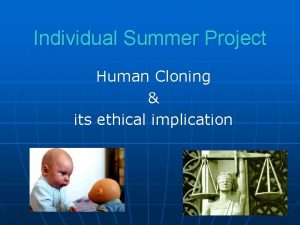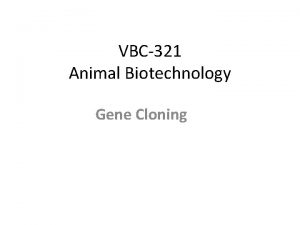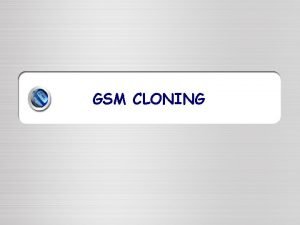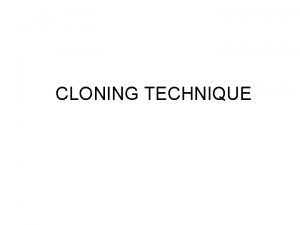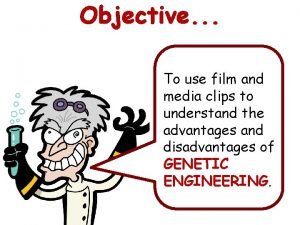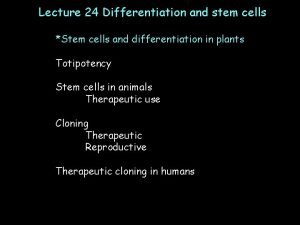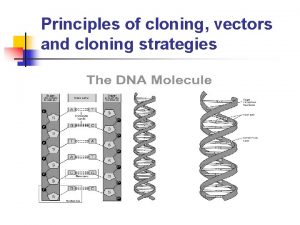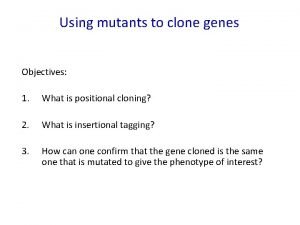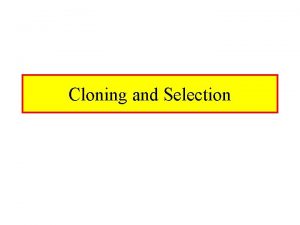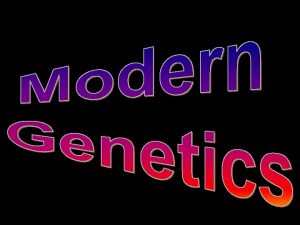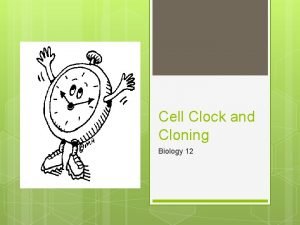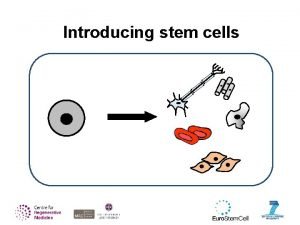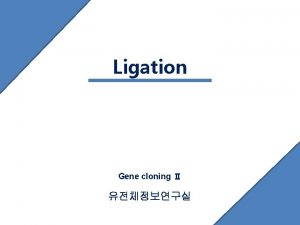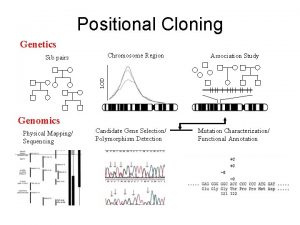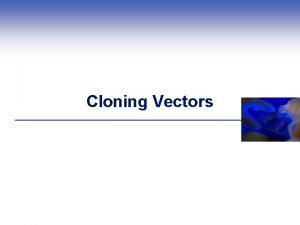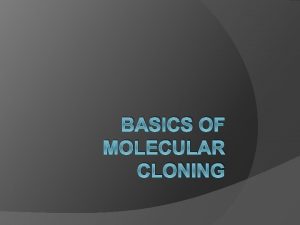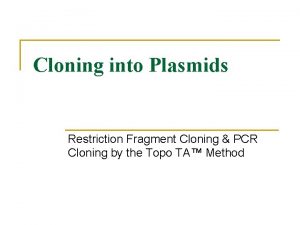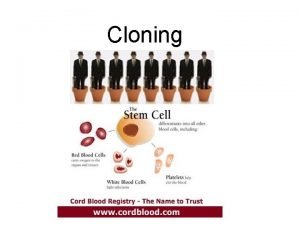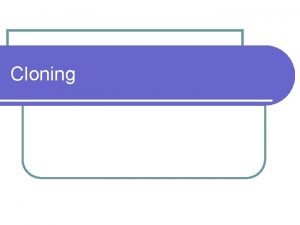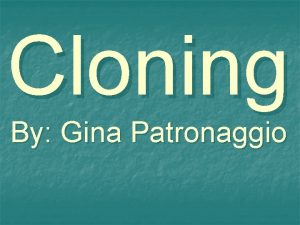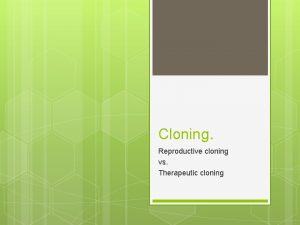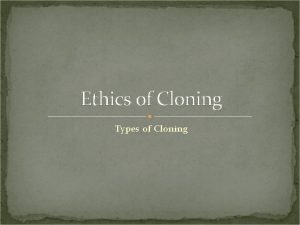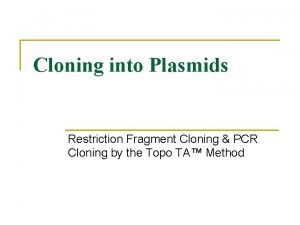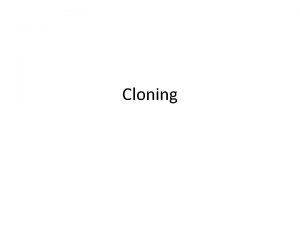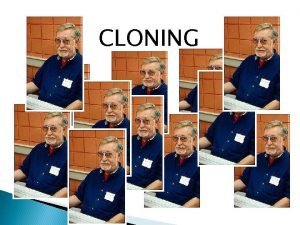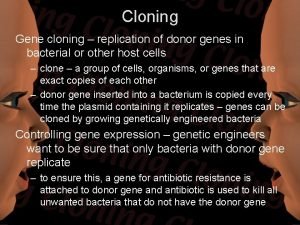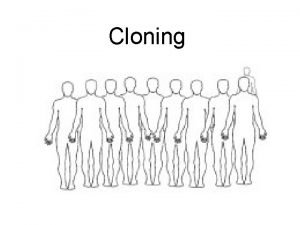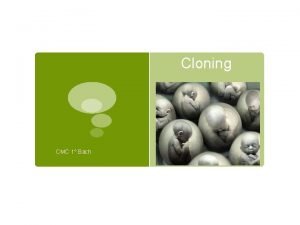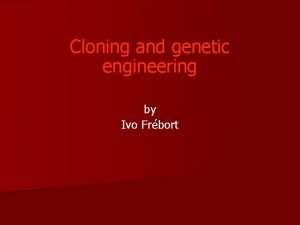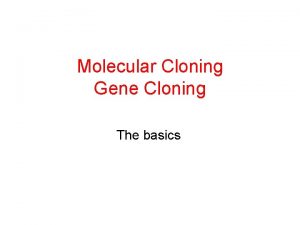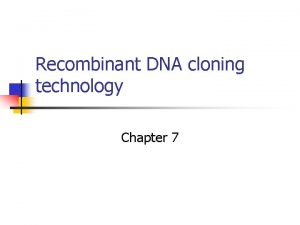Cloning Cloning What is it l The production


























- Slides: 26

Cloning

Cloning: What is it? l The production of multiple, exact copies of a single gene, DNA fragment, cell line, or organism. l 3 types of cloning technology today: recombinant DNA technology, reproductive cloning, and therapeutic cloning

Cloning in Animals l Organisms that are genetically identical are clones l Identical twins are clones l Asexual Reproduction always produces clones

Asexual Reproduction in Plants

History of Cloning l 1950’s first experiments done with frogs. l l l Needed very early embryo cells to survive Found that the tadpoles that did arise would not develop into adults Results gave support to the idea that differentiated cells could not be used to create clones

History of Cloning 1996 - 2014: Meng and Wolf clone monkeys from embryonic cell nuclei; b) Wakayama clones mice from adult cell nuclei; c) Wells clones cows from adult cell nuclei; d) Severino Antinori proposes to reproductively clone humans. a) 6

Examples of Cloned Animals

More Examples of Clones

Heres Dolly!!! l Wilmut et al. Produced “Dolly” in 1997 l Used Genetic Information Taken from Udder of Adult Sheep

l Dolly

l Dolly was born July 5, 1996 to three mothers 1 donated the egg, 1 donated the DNA and the other was the surrogate. Dolly lived only 6 years

Human Cloning l Difference Between: Therapeutic Cloning – Culturing of Human Cells for use in Treating Medical Disorders l Reproductive Cloning – Development of a cloned human embryo for the purpose of creating a cloned human being l

http: //upload. wikimedia. org/wikipedia/commons/thumb/6/6 b/Cloning_diagram_english. pn g/300 px-Cloning_diagram_english. png

Benefits of Cloning Transgenic Animals for - Drug creation- more cost effective - Xenotransplantation from 1 species to another - Immune suppressed animals to study human diseases l Baby Fae received the first baboon heart in 1984

Benefits of Cloning § Disease-resistant farm animals § Crops that are disease, insect, and drought resistant

Cosmetic Surgery l Doctors will be able to manufacture bone, fat, connective tissue, or cartilage that matches the patients tissues exactly

Infertility Patients l Will allow infertility patients to have their own biological child (current infertility treatments are only about 10% effective and very costly both monetarily and mentally on the parents) l Will allow parents to have offspring that are free of genetic disease (cystic fibrosis, Huntington’s, etc…)

Controversy over Therapeutic Cloning l Question arises- Does Life Begin At Conception? l Uses the process of nuclear somatic transfer to create an embryo. l However, the embryo is destroyed and harvested for stem cells.

Extremely High Failure Rate Animal cloning has proven highly unsuccessful l Dolly- only 20 embryos grew out of over 400 attempts l Snuppy-only obtained three pregnancies from more than 1, 000 embryo transfers into 123 recipients l Kittens have very little success as well l

Problems During Later Development Out of the 20 sheep embryos that grew, 19 were either stillborn or stopped developing due to birth defects (Dolly was the only survivor out of over 400 attempts) l 1 of the 3 puppy embryos that was growing miscarried and 1 died shortly after birth (Snuppy was the only survivor out of over 1, 000 attempts) l Most clones are born with Large Offspring Syndrome (they are abnormally large) This means they have larger organs, which leads to breathing, blood flow, and other problems l

Legal Aspects of Human Cloning l Funding- should governments fund cloning? l Reproductive cloning is prohibited in 15 states and 6 prohibit therapeutic as well l What is the legal status of a clone?

UNESCO: Universal Declaration on the Human Genome and Human Rights of 11 November 1997: “Practices which are contrary to human dignity, such as reproductive cloning of human beings, shall not be permitted”. 22

WHO: Resolution adopted in 14 May 1997, on the 50 th World Health Assembly: “the use of cloning for the replication of human individuals is ethically unacceptable and contrary to human integrity and morality”. 23

Council of Europe: Recommendation 1046 (1986) on the use of human embryos and foetuses for diagnostic, therapeutic, scientific, industrial and commercial purposes; b) Principles on human artificial procreation (1989); c) Additional protocol to the CHRB, on the prohibition of cloning human beings (1998). a) 24

Moral Dilemma l What does it mean to be a person? l Cloning goes against every major religious view l Human dignity is in question- every person has the right to be unique

 Production pre production post production
Production pre production post production Cloning and sequencing explorer series
Cloning and sequencing explorer series Human cloning cons
Human cloning cons Directional topo cloning
Directional topo cloning Cloning
Cloning Metyláza kofaktor
Metyláza kofaktor Plasmid
Plasmid Cloning vector
Cloning vector Cloning pros and cons
Cloning pros and cons How is selective breeding accomplished
How is selective breeding accomplished Gsm cloning
Gsm cloning Reproductive cloning process
Reproductive cloning process Advantages and disadvantages of cloning
Advantages and disadvantages of cloning Therpeutic cloning
Therpeutic cloning Identity cloning and concealment
Identity cloning and concealment Advantages of cloning
Advantages of cloning Cosmid vector slideshare
Cosmid vector slideshare Map based cloning
Map based cloning Suspension cloning
Suspension cloning Process of cloning
Process of cloning Advantages and disadvantages of cloning
Advantages and disadvantages of cloning Cloning in nature
Cloning in nature Reproductive cloning
Reproductive cloning Gene cloning
Gene cloning Positional cloning
Positional cloning Clock gate cloning
Clock gate cloning Gene cloning
Gene cloning


